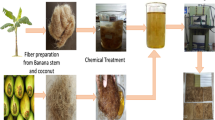Abstract
The crosslinked biopolymer structure constructed by blending different biopolymers or adding crosslink agent to biopolymers was studied. The rate of crosslink reaction was estimated with rheological measurements, such as elasticity and viscosity, glass transition temperature, crosslinking density, and gelation. Intermolecular and intramolecular association among polymer chains resulted in the formation of a complex three-dimensional (3-D) network as a single, double, or triple helix. These aggregates are progressively disrupted under an influence of applied shear forces that can be heat or pressure for a long period time. Nonetheless, such crosslinked structure exhibited the unique properties that may be found in a crosslinked structure. Therefore, such 3-D crosslinked structure can make an effective tool to stabilize such hazardous materials as heavy metals, toxic organics, and radioactive waste in a subsurface engineering system. In this study, the rate of crosslinking reaction in a biopolymer structure was fundamentally determined with the measurement of rheological properties.











Similar content being viewed by others
References
Crueger W, Crueger A (1990) Biotechnology: a textbook of industrial microbiology, 2nd edn. Sinauer Association Inc.
Goel N, Shah S, Grady B (2002) Correlating viscoelastic measurements of fracturing fluid to particles suspension and solids transport. J Petrol Sci Eng 35:59–81
Goodwin JW, Hughes RW (2000) Rheology for chemists: an introduction. The Royal Society of Chemistry, pp 2–14
Guenet JM (1992) Thermoreversible gelation of polymers and biopolymers. Academic Press Inc.
Harris PC (1993) Chemistry and rheology of borate-crosslinked fluids at temperatures to 300°F. J Petrol Technol 1:264–269
Kesavan S, Prudhomme R (1992) Rheology of guar and HPG cross-linked by borate. Macromolecules 25:2026–2032
Kim DI, Petrisor IG, Yen TF (2005) Evaluation of biopolymer-modified concrete systems for disposal of cathode ray tube glass. J Air and Waste Manage 55:961–969
Kim DI, Lai HT, Chilingar GV, Yen TF (2006) Geopolymer formation and its unique properties. Environ Geol 51:103–111
Kim DI, Quinlan M, Yen TF (2009) Encapsulation of lead from hazardous CRT glass wastes using biopolymer-crosslinked concrete systems. Waste Manage 29:321–328
Kim DI, Park JS, Yen TF (2012) Feasibility study on cross-linked biopolymeric concrete encapsulating selenium glass wastes. Air Waste Manage Asso 62(8):898–904
Lai HT, Kim DI, Park JS, Yen TF (2013) Studies of crosslinked biopolymer structure for environmental tools in terms of the rate of weight swelling ratio, viscosity, and biodegradability: part A. Environ Earth Sci 70:2405–2413
Rosen SL (1993) Fundamental principles of polymeric materials, 2nd edn. John Wiley and Sons Inc.
Stuart BH (2002) Polymer analysis. John Wiley and Sons Inc., pp 217–220
Tombs MP, Harding SE (1998) An introduction to polysaccharide biotechnology. Taylor and Francis, pp 1–46
Wan MW, Petrisor IG, Lai HT, Kim DI, Yen TF (2004) Copper adsorption through chitosan immobilized on sand to demonstrate the feasibility for in situ soil decontamination. Carbohydr Polym 55:249–254
Yen TF (1999) Environmental Chemistry Vol. 4A. 617
Zhao Y, Cao Y, Yang Y, Wu C (2003) Rheological study of the sol-gel transition of hybrid gels. Macromolecules 36:855–859
Acknowledgements
Authors would like to thank to Dr. Christine Lai for the data set.
Author information
Authors and Affiliations
Corresponding author
Additional information
Publisher's Note
Springer Nature remains neutral with regard to jurisdictional claims in published maps and institutional affiliations.
Rights and permissions
About this article
Cite this article
Kim, D., Park, JS., Wang, R. et al. Studies of crosslinked biopolymer structure for environmental tools in terms of the rheological measurements: part B. Environ Earth Sci 80, 311 (2021). https://doi.org/10.1007/s12665-021-09549-y
Received:
Accepted:
Published:
DOI: https://doi.org/10.1007/s12665-021-09549-y




